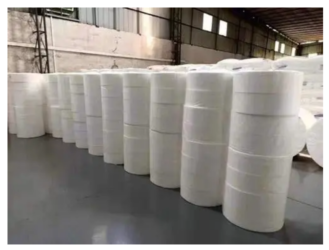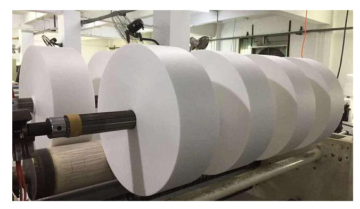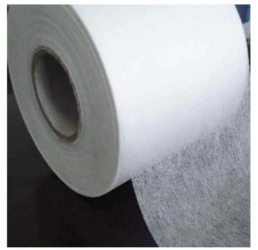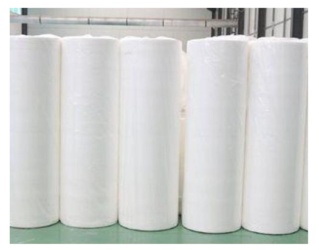Introduction to melt blown fabrics

Melt blown cloth is the most core material of the mask. Melt blown cloth is mainly made of polypropylene as the main raw material, and the fiber diameter can reach 1~5 microns.
With more voids, fluffy structure and good wrinkle resistance, the ultra-fine fibers with unique capillary structure increase the number and surface area of fibers per unit area, thus making mel tblown cloth have good filtering, shielding, adiabatic and oil absorption properties.
It can be used in the fields of air and liquid filtration materials, isolation materials, absorbing materials, mask materials, warming materials, oil absorbing materials and wiping cloths.On March 8, 2020, the SASAC of the State Council introduced to the public that in the face of the demand for mel tblown cloth, the core material of masks, the SASAC of the State Council guided and promoted relevant central enterprises to speed up the construction of production lines and put them into production as soon as possible to expand the market supply of melt blown cloth and provide protection for epidemic prevention and control.
According to the news of SASAC’s special working group on medical materials, as of 24:00 on March 6, the output of melt blown cloth of central enterprises reached about 26 tons on that day.
With the new production line completed and put into operation, the output of melt blown cloth is expected to increase significantly in the coming week. SASAC and central enterprises will continue to make more efforts to ensure the supply of medical materials such as raw materials for medical mask production.

Contents
1. Basic introduction of melt blown fabric
Melt blown fabric is the most core material of masks. Medical masks and N95 masks are composed of spunbond layer, melt blown layer and spunbond layer, of which, spunbond layer and melt blown layer are composed of polypropylene PP material
2. Application range of melt blown fabric
(1) Medical and health care fabrics: surgical gowns, protective clothing, disinfection wraps, masks, diapers, women’s sanitary napkins, etc.
(2) Home decoration fabrics: wall coverings, tablecloths, bed sheets, bedspreads, etc.
(3) Apparel fabrics: lining, bonded lining, wadding, shaped cotton, various synthetic leather base cloths, etc.
(4) Industrial fabrics: filter materials, insulation materials, cement bags, geotextiles, coverings, etc.
(5) Agricultural fabrics: crop protection cloth, rice planting cloth, irrigation cloth, insulation curtain, etc.
(6) Others: space wool, thermal insulation materials, oil-absorbing felt, cigarette filters, bags of tea bags, etc.
Melt blown cloth filter material is made of polypropylene ultra-fine fibers randomly distributed dip knotted together, the appearance of white, flat, soft, material fiber fineness of 0.5-1.0μm, the random distribution of fibers provides more opportunities for thermal bonding between fibers, thus making meltblown gas filter material has a larger specific surface area, higher porosity (≥75%). After high pressure electret filtration efficiency, so that the product has low resistance, high efficiency, high dust capacity and other characteristics

3. Main specifications of meltblown fabric
Grammage: 18g-500g
Width: Generally 160cm and 180cm (also according to customer demand)
The meltblown fabric is made by using high speed hot air flow to draw the polymer melt stream extruded from the spout hole of the die, thus forming ultra-fine fibers and collecting them on the curtain or roller of the condensation net, while bonding itself to become meltblown nonwoven fabric.
The production process of meltblown fabrics is mainly as follows
1. Melt preparation
2. Filtration
3. Metering
4. Melt extrusion from the spinneret hole
5. Melt fine flow drafting and cooling
6. Mesh formation
4. Application of meltblown fabric products
Cloths for medical hygiene: surgical gowns, protective clothing, disinfection wraps, masks, diapers, women’s sanitary napkins, etc.
Cloths for home decoration: wall coverings, tablecloths, bed sheets, bedspreads, etc.
Cloths for garments: lining, bonded lining, wadding, shaped cotton, various synthetic leather backings, etc.
Industrial fabrics: filter materials, insulation materials, cement packaging bags, geotextiles, coverings, etc.
Agricultural fabrics: crop protection fabrics, rice planting fabrics, irrigation fabrics, insulation curtains, etc.
Others: space wool, heat and sound insulation materials, oil-absorbing felt, cigarette filters, bagged tea bags, etc.

5. Advantages of meltblown fabric.
Light weight: polypropylene synthetic resin as the main content of the production enterprise raw materials, specific gravity of only 0.9, only three-fifths of the Chinese cotton, with fluffy, feel good.
It is made of fine fibers (2-3D) with hot-melt bonding… The finished product has moderate softness and comfort.
Water repellent, breathable: non-absorbent polypropylene chips, zero moisture, finished water side, by having porous, breathable, easy to maintain dry cloth 100 kinds of % of fibers, easy to rinse.
Non-toxic, non-irritating: products can be produced using more in line with FDA food-grade raw materials, does not contain any other student chemical ingredients, relatively stable performance, non-toxic, odorless, does not irritate the skin.
Antibacterial and chemical resistance: polypropylene is a chemically blunt substance, not moth, can isolate the presence of bacteria and insects in the liquid;
antibacterial, alkali corrosion, the finished product does not affect the erosion strength.

Antibacterial properties: pull with water-based, mold, bacteria and insects and liquid can be isolated from the presence of erosion, mold moth said products.
Good physical properties: spinning from polypropylene can be directly laid into a net of hot bonding effect, the product has better strength than the general staple fiber products, strength without directionality, longitudinal and transverse structural strength as well as similar.
In terms of environmental protection, the raw material of most of the non-woven fabrics used is polypropylene, while the raw material of plastic bags is polyethylene, although the names of the two substances are similar, but the chemical structure is very different
. The chemical molecular structure of polyethylene is quite stable and extremely difficult to degrade, so plastic bags need 300 years to decompose;
while the chemical structure of polypropylene is not strong, the molecular chain is easy to break, so it can be effectively degraded and enter the next environmental cycle in a non-toxic form, a non-woven bag can be completely decomposed within 90 days. And non-woven shopping bags can be reused more than 10 times, waste after the pollution of the environment is only 10% of plastic bags.

 By Coco Ho
By Coco Ho

